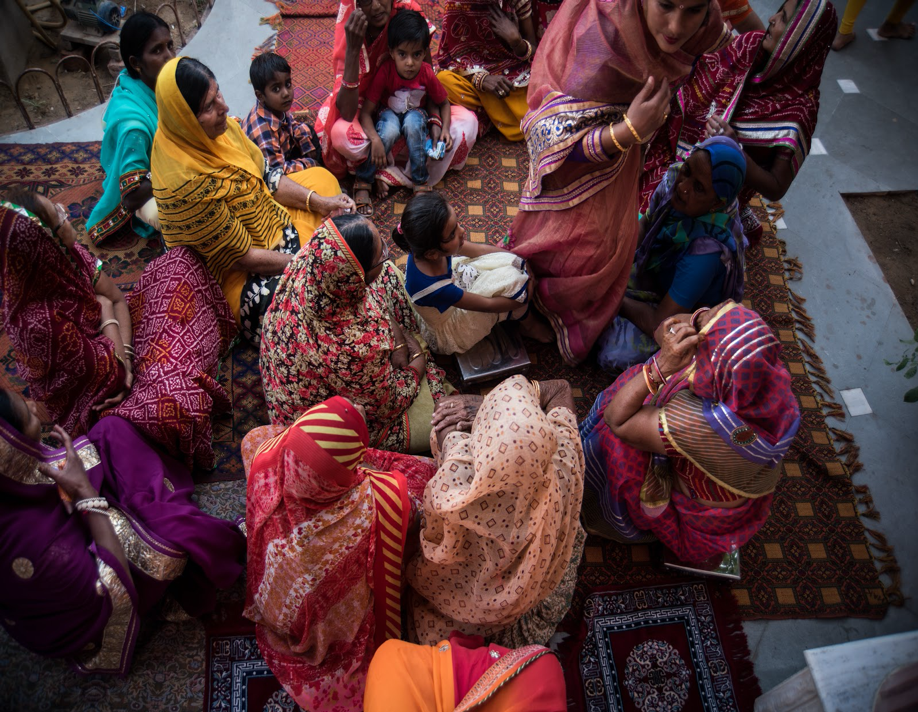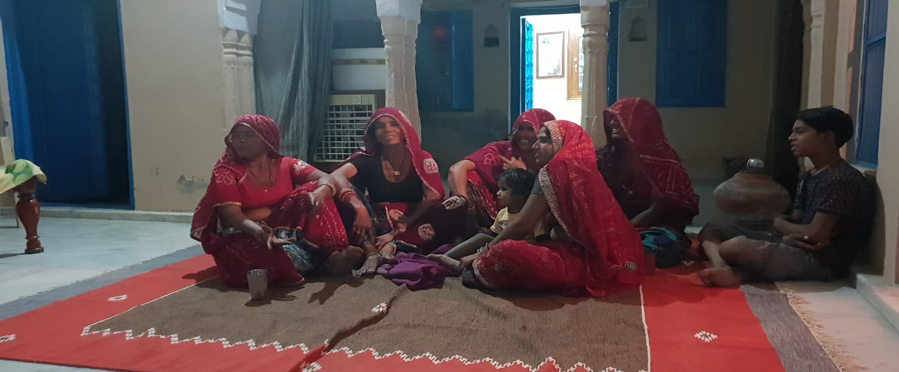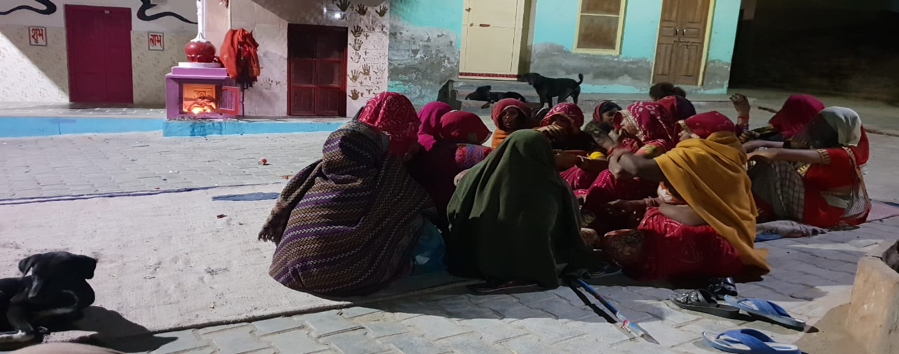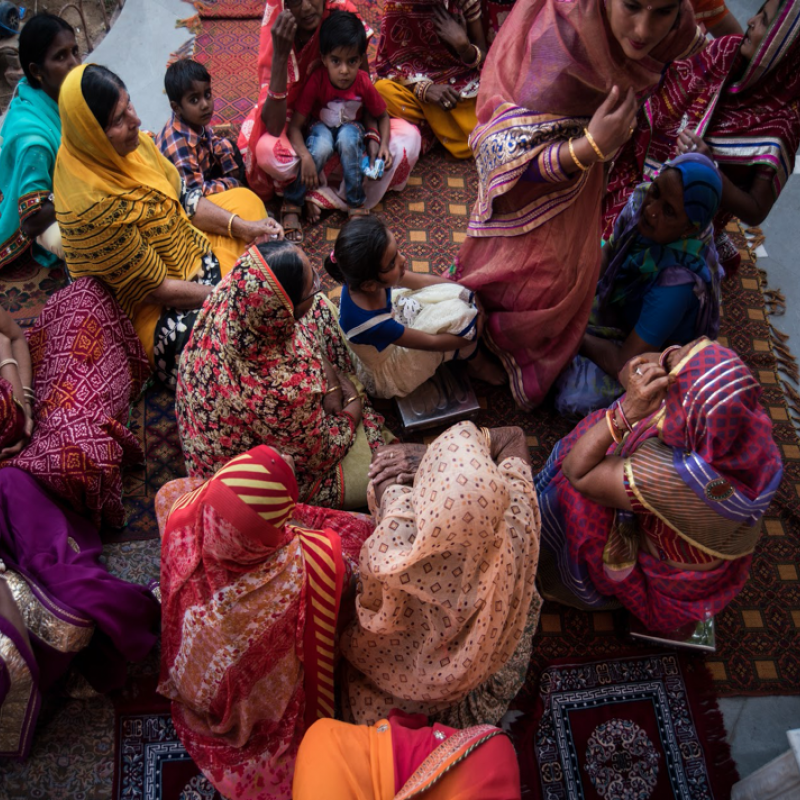Women’s voices in South Asian history can be hard to come by. Even when written genealogies and histories, epics and religious treatises mention women, they treat them as ‘subjects’ or plot devices furthering male narratives. If one turns to oral traditions, however, one finds abundant presence of women. Women are the composers, tellers and listeners of many oral traditions—mythologies, ballads, songs and tales—often with their accompanying rituals.
Women singing songs to various folk deities forms an important part of the rituals of all auspicious ceremonies and rites of passage. The songs provide rich material for anthropological enquiry. The singing, along with accompanying rituals, involves the extended family and the local community and becomes a way of reinforcing identity and ties of kinship, and of commemorating historical events. Further, these traditions often express close relationships with the local environment and ecology. (Fig.1)

The worship of folk deities is a pan-Rajasthan phenomenon, and extends to its neighbouring regions as well. While the worship of some deities (such as Ramdevji) is spread across a large geographic region, the worship of others may be confined to a particular region (such as in the case of local bhomiyas and satis). Further, the worship of ancestor deities, the pitar, is confined to one family or clan only. There is a deity for every occasion and each hardship: one deity—Gogaji—is thought to cure snake bite, another—Sitala—small pox, for childlessness there is Bheruji, while still others—such as Tejaji—are worshipped at the time of sowing a crop. Thus, the reasons for the worship of these deities vary as much as the spread of the cults.
Most of these deities—such as Pabuji, Tejaji and Gogaji—are bhomiya deities, brave warriors who lost their lives fighting to protect the village cattle. Other acts of bravery are also associated with the lives of these heroes. Female deities are often, but not always, satis. While the lore around these deities depict them as historical figures, available records do not usually throw up any clear matches with the information or events described in local legends.

The very processes of deification appear to revolve around the deities’ ability to intervene in people’s daily lives. The common feature associated with all the deities is that they have appeared or have spoken to people—in dreams or sometimes by possessing the people—and use their powers to help people with the problems of their everyday lives. Consider, for example, Maharana Pratap or Rani Padmini. As Komal Kothari points out, the former died protecting his people, and the latter is believed to have committed jauhar [self-immolation].[1] Tales of both these figures are known widely but neither is venerated as a deity. This is because they have neither appeared to nor spoken to anyone after their death, nor are they believed to use their powers to help people. It is this aspect that perhaps explains how among countless war heroes and satis through the ages, only a few are venerated and remembered as deities. Further, it is believed that these gods can also be wrathful if their worship and remembrance is neglected. Pitar deities, for instance, are thought to be particularly sensitive.
Shrines to such deities are structurally simple and can be found dotting country roads, highways, villages, towns and cities. These miniature temples have placed in them a simplistic representation of the deity, most often a low-relief stone sculpture. (Fig. 2) Often, some shrines become important centres of pilgrimage and evolve into more elaborate temples.

The worship of such deities is associated with diverse musical traditions, and the Brahmin priest or Brahminical rituals such as yajnas are conspicuously absent. The day-to-day access to such deities is intimate and direct. Several musician communities are involved in ritual singing and worship of the deities, such as the Bhopas, Jogis and other caste musicians, and performers sing about the lives and miracles of these deities. Some communities—for example, the Bhopas of Pabuji—are devoted exclusively to singing about a particular deity.
Women as Composers, Tellers and Listeners of Ritual Music
Ritual singing in non-musician communities is prevalent across all castes, with variations depending on family, clan, caste and region. The carriers of the tradition are always women, and the occasions for such singing include birth, marriage and various festivals. The songs can describe episodes from a particular deity’s life, prescribe modes of worship or make requests for the well-being of the family or clan. Ritual singing usually happens within the family’s private space, such as the aangan or inner courtyard, but can often also involve processions to another family member’s house, to the neighbouring well or to a nearby shrine. If there is a marriage in the family, singing can start several days before the actual event. Women congregate in the afternoons and late evenings and start with the songs sung to the family’s deities, before proceeding to wedding songs. The night before a wedding or any other major auspicious occasion is a ratijoga (literally, all-nighter), where women sing and dance through the night. Different songs are sung at different times of the night. By involving near and distant relations and neighbours, including women from other castes, this singing becomes a ritual carried out in and by the local community.
While such ritual singing is to be found across all castes, some deities are specific to certain castes. For example, consider Ramdevji and his ardent follower from the Meghwal community, Dali Bai. Dali Bai is believed to have taken samadhi before Ramdevji. Most Ramdevji shrines are always accompanied by a Dali Bai shrine. While Ramdevji has a following across castes, Dali Bai songs are found only in Dalit communities.
A noteworthy aspect of ritual singing is that it needs to adhere to strict rules. For example, in many families widows do not begin a song, though they may join in later. The family deity is always invoked first and the order of singing these songs is important. Despite this, these rituals are distinct from Brahminical or Puranic rituals, most notably in the absence of a Brahmin intermediary. The singing of these songs constitutes the primary mode of worship, with the singing being not an accompaniment to worship or ritual, but the worship or ritual itself.[2] They variously describe episodes from the deity’s life, praise them for their generosity, and request for the well-being of their families.
Even while this singing is ritualistic, there is of course ample transmutation and flexibility, which is the hallmark of traditions transmitted orally. Many songs have remained unchanged for long periods of time—this can be seen even from the use of words and phrases that have fallen out of current use. Many women believe that these songs were the gods’ own compositions. On the other hand, there is also a great deal of change—often women compose songs based on popular tunes. Village exogamy—the tradition of favouring marriage for daughters of the family in villages other than their parental villages—ensures a constant flow and intermixing of regional traditions.
The accessibility and ‘everyday-ness’ of these deities is remarkable. The pitars bathe in the village pond. In one song, Mataji tells her devotees about her human origins and her subsequent elevation to divine status. In yet another, a woman confides in Bheruji that childlessness has made her life horrible—and that her father-in-law and mother-in-law do not even want to see her face—and requests Bheruji to not put further shame on her breast milk, and perform a miracle so that she has children. Often women approach folk deities for cures for their gynecological ailments, known as purde ki bimaari. Perhaps this accessibility and intimacy is because of the absence of the Brahmin intermediary or is it the other way round? (Figs. 3 and 4)


The worship of folk deities shows close ties of the family to its local history and environment.[3] The origin myths of these deities are often closely linked to the local environment. Moreover, the shrines themselves are often located under or near banyan or peepal trees, which begin to be regarded as sacred. The deities are believed to delight in the greenery around their shrines and also the company of small animals and birds, and are known to inflict punishment on those who damage the greenery around their shrines.
The study of women’s songs in Rajasthan reveals quite starkly the contrast between the stereotype of the docile and submissive Rajasthani woman and the assertive, demanding and bold woman one encounters in folk songs. A woman in a rural Rajasthani household would not be expected to subvert the social codes of etiquette by addressing senior male members of the household or speak to males from outside the household. However, as can be seen in several of the song transcriptions made as part of this project, one finds the women summoning the carpenter or the kandoi (confectioner), or demanding and ordering senior male members of the household. Often they demand gifts from their fathers-in-law and sing abuse at relations. How does this inversion occur? Perhaps norms of individual behaviour do not apply to groups? While a woman may not be expected to address her father-in-law directly, it is acceptable for her to be part of a large group of women singing directly at the father-in-law. Thus, congregation allows a social subterfuge. Moreover, when such collective singing happens, the singer or narrator in the song still remains an individual. Thus a collective singular is established—the group seizing more agency than each individual in it, even though each woman in the group may be singing to different intended listeners.
Some scholars regard such inversions as ‘rituals of rebellion’ which act as outlets of release, and thus in the long run further buttress status quo and its power gradients. Other scholars believe such inversions keep the possibility of alternative power gradients and change alive and have actual impact on social life.[4]
When the song narrates episodes from the deities’ lives or promises worship and adulation in particular forms, the commemoration of important events and figures of the region becomes institutionalised. The worship of pitars becomes a family’s way of remembering an event in its own history. In one song recorded in a Meghwal community in Ratangarh, the women recounted the death of a senior male family member and the composition of a song venerating him as a family deity on the very night of his death. Since then, the song is the first song sung at any auspicious occasion in the clan. The taking of names of male members in the extended family in each song plays out the function of reinforcing kinship ties. In communities where these traditions are absent, this task would again be the responsibility of the Brahmin.
Lineage, kinship and history play a crucial part in the formation of a family’s and community’s identity. It is noteworthy that women are the vehicles of identity and the source of a family’s conception of its history. One is reminded of Partha Chatterjee’s argument of women emerging as the guardians of the ‘inner’ spiritual sanctorum of the home and its traditions, while men had to negotiate a deracinated ‘outer’.[5]
Notes
[1] Bharucha and Kothari, Rajasthan, an Oral History: Conversations with Komal Kothari.
[2] There are of course Bhopas or bards, often associated with specific shrines, who narrate ballads and tales from the lives of these deities as, for example, the Bhopas of Devnarayanji and Pabuji. Visits to these shrines or visits from these Bhopas, however, do not form a regular part of marriages and auspicious occasions. The deities are worshipped primarily by singing.
[3] Gold, ‘Deep Beauty.’
[4] Raheja and Gold, Listen to the Heron's Words.
[5] Chatterjee, ‘Colonialism, Nationalism, and Colonialized Women.’
Bibliography
Chatterjee, Partha. ‘Colonialism, Nationalism, and Colonialized Women: The Contest in India.’ American Ethnologist 16, no. 4 (1989): 622–33.
Cort, John. ‘Medieval Jaina Goddess Traditions.’ Numen 34, no. 2 (1987): 235–55.
Dhali, Rajshree. ‘Popular Religion in Rajasthan: A Study of Four Deities and Their Worship in the Nineteenth and Twentieth Century.’ PhD thesis, School of Social Sciences, Jawaharlal Nehru University, 2004.
Gold, A. ‘Deep Beauty: Rajasthani Goddess Shrines Above and Below the Surface.’ International Journal of Hindu Studies 12, no. 2 (2008): 153–79.
———. ‘Outspoken Women-Representations of Women in a Rajashani Folklore Community.’ Oral Tradition 12, no.1 (1997): 101–33.
Gold, Ann Grodzins, and Bhoju Ram Gujar. ‘Of Gods, Trees and Boundaries: Divine Conservation in Rajasthan.’ Asian Folklore Studies 48, no. 2 (1989): 211–29.
Jammad, Shrikanwar. Geet Rajasthani. Sardarshahar: Shri Prakashan, 1998.
Jassal, Smita Tewari. Unearthing Gender: Folksongs of North India. Durham, NC: Duke University Press, 2012.
Narayan, K. Everyday Creativity: Singing Goddesses in the Himalayan foothills. Chicago: The University of Chicago Press, 2016.
Neuman, Daniel, Shubha Chaudhuri and Komal Kothari. ‘Bards, Ballads and Boundaries: An Ethnographic Atlas of Music Traditions in West Rajasthan.’ Calcutta: Seagull Books, 2006.
Pinney, Chris. ‘The Accidental Ramdevji.’ In India’s Popular Culture: Iconic Images and Fluid Spaces, edited by Jyotindra Jain. Mumbai: Marg, 2008.
Raheja, Gloria Goodwin, and Ann Grodzins Gold. Listen to the Heron's Words: Reimagining Gender and Kinship in North India. Berkeley: University of California Press, 1994.
Ramanujan, A.K. ‘Who needs folklore? Ramanujan on Folklore.’ Indian Literature 37, no. 4 (1994): 93–106.
Smith, John D. The Epic of Pabuji: A Study, Transcription, and Translation. Cambridge: Cambridge University Press, 1991.
Wadley, Susan S. ‘Śītalā: The Cool One.’ Asian Folklore Studies 39, no. 1 (1980): 33–62.

